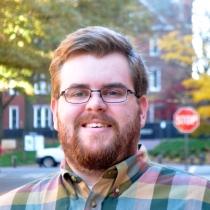
Ryan Armstrong
After graduation, what's your next adventure?
I will be going to Fort Worth, Texas to work for Lockheed Martin at Skunk Works. I will be a systems engineer doing operations analysis. I’ll be quantifying the impact of new technologies and operational concepts. I’ll be doing force mix calculations, which essentially looks at a fleet and determines, economically, what mix of technologies are needed to accomplish the mission. You might say, at first, send in all of your new systems, but you have to ask yourself what the ROI is. Maybe a different mix of older and newer will accomplish the same thing at a lower cost.
What about your next adventure are you most excited about?
I knew when I came to Tech that I wanted to affect the future of aircraft and flight. Skunk Works is on the cutting edge of just that – doing it every day. It’s exciting, because you get to play with stuff when it’s just an idea floating around there. But it also takes confidence in your knowledge. The design process has a lot of steps, and people pour themselves into that. Somewhere along the line, someone like me has to come in and say ‘Great, but does it add value? Is it worth it?’ And that’s when you’ve got to be willing to call someone’s baby ‘ugly.’ That’s hard.
Did you have any previous co-op internship or research experience that helped you get to this point? I worked at Lockheed Martin before I came to Tech as a systems engineer. I did supplier statements of work. The summer after I came to Tech I interned at Skunk Works as an operations analyst and there it was: the dream job I never knew I wanted. It is exactly why I came to Tech. At the end of that summer, I told them I was going back to Tech to pursue a PhD, and they said ‘You can do that, but you already have this job.’
How did your educational experience at Georgia Tech help you achieve your goal?
As an undergraduate at Texas Tech, I was a mechanical engineering major. Now ME is good in a lot of areas, but it tends more toward detail design where AE is more conceptual design, coming up with a shape and a goal. So when I came to Georgia Tech I had a lot of catching up to do. I was so impressed with how Professor [Dimitri] Mavris knew where to place me. Within a week, he knew what I was good at and where my weaknesses were. He threw me into things that scared me, but he also put me in with a team that was a perfect fit. I saw my first helicopter, up close, when I got to Tech and I thought ‘That’s neat. I have no idea how it works.’ Eight months later, I presented a paper on it in front of the American Helicopter Society.
What advice would you give a student who was thinking about following your steps at Georgia Tech's aerospace engineering school? First piece of advice I’d give anyone coming to Tech is: don’t say ‘no’ to something just because it’s new or you don’t understand it at first. I remember one of my projects involved UAVs for the US Special Ops Command. There was some electrical engineering and controls stuff that was really outside my comfort zone. Dr. Mavris knew that – it’s probably why he assigned me. And I’m better for it. It built my confidence and helped me every time I had to go into a project and learn new material. The other piece of advice I’d give is: believe in yourself. Georgia Tech’s ranking can rattle you. Coming here from Texas, which was a good school, I was still wondering if I belonged here. I did, and I’m glad that I stuck it out because, through Dr. Mavris, I saw the importance of building a strong team, with different skills and abilities spread out across different individuals.